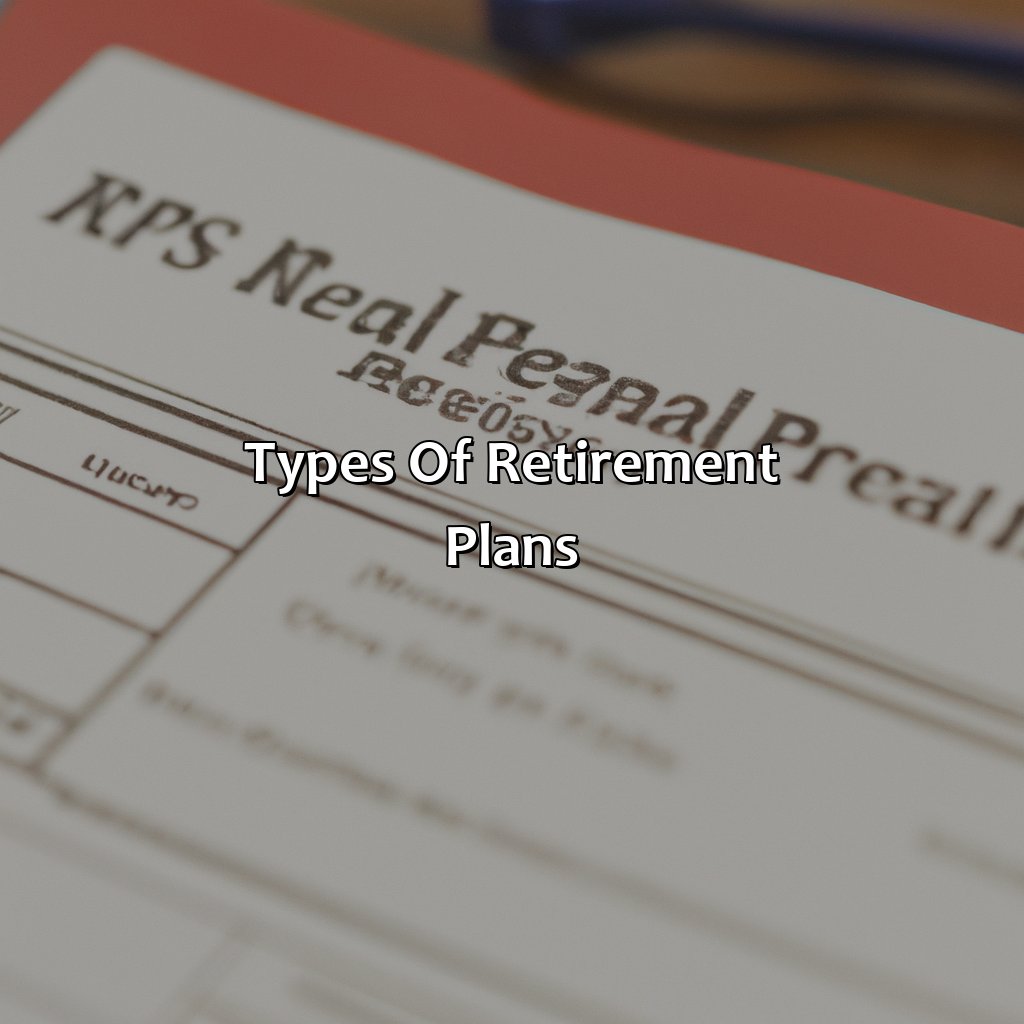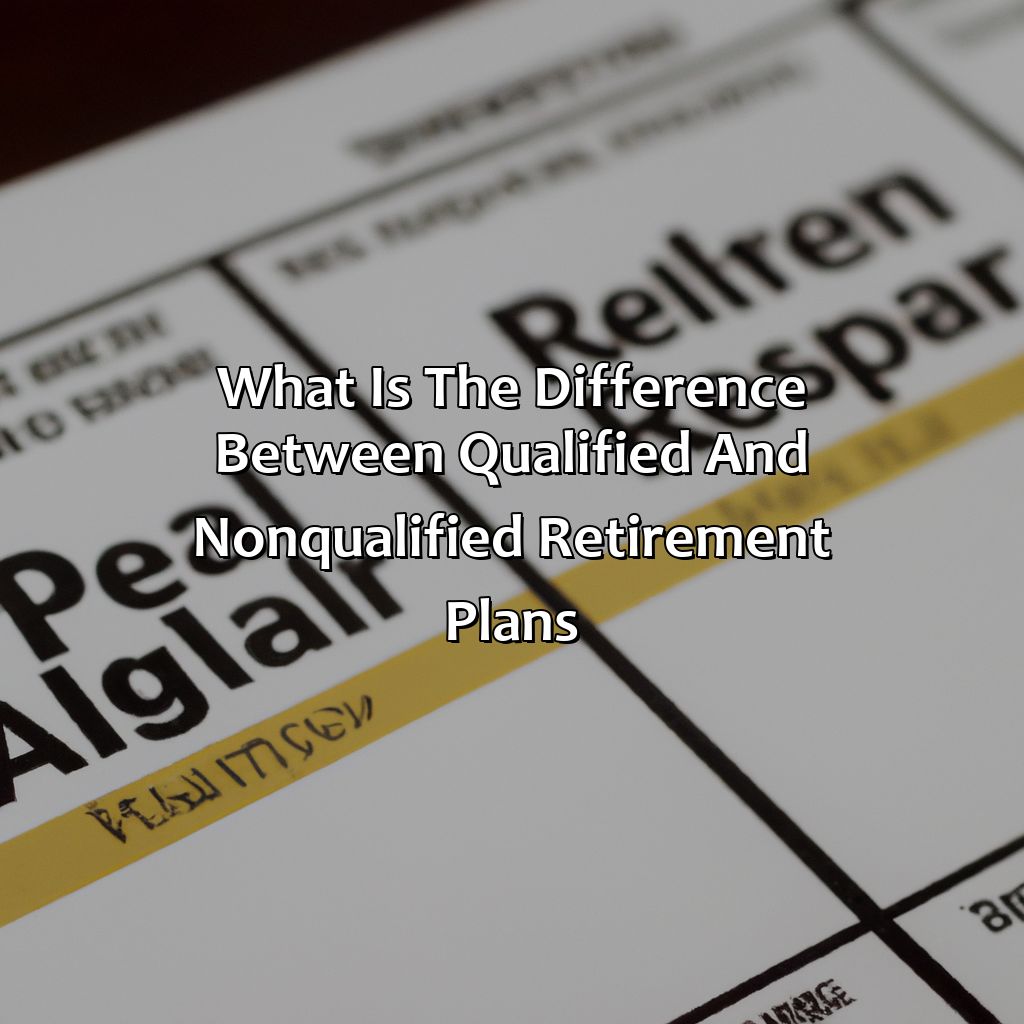What Is The Difference Between Qualified And Nonqualified Retirement Plans?
Key Takeaway:
- Qualified retirement plans are employer-sponsored retirement plans that meet specific Internal Revenue Service (IRS) guidelines, while nonqualified plans do not. Qualified plans offer tax benefits to both employers and employees, while nonqualified plans are not eligible for tax deductions.
- Qualified plans have contribution limits set by the IRS, while nonqualified plans have no such restrictions. Vesting, or the degree of ownership employees have over their retirement account, is also different between the two types of plans. Qualified plans have strict vesting schedules, while nonqualified plans offer greater flexibility in this regard.
- The regulatory oversight for qualified plans is higher, as they must meet certain legal requirements, such as providing certain types of benefits to all eligible employees. Nonqualified plans, on the other hand, are typically designed for select groups of executives and high earners, and do not have the same regulatory oversight as qualified plans.
Are you confused by the differences between qualified and nonqualified retirement plans? This article helps demystify the two, giving you the clarity you need to understand and use each one. You’ll get insight into which plan best meets your retirement needs.
Types of Retirement Plans
To investigate Types of Retirement Plans, let’s consider Qualified and Nonqualified Plans. The IRS regulates Qualified Plans, but not Nonqualified Plans. Both kinds of plans vary in funding, contributors, and withdrawal regulations.

Image credits: retiregenz.com by James Duncun
Qualified Retirement Plans
Retirement plans that meet the criteria established by the Internal Revenue Service (IRS) are called Qualified Retirement Plans. These plans offer tax benefits and allow employees to save for retirement. Employers can deduct contributions from their income, which reduces taxable income. However, withdrawals are taxed as ordinary income when retired workers begin to receive payments.
These qualified plans include 401(k)s, 403(b)s, profit-sharing plans, money purchase pension plans, and defined benefit pension plans. Contributions made by both employees and employers go into these accounts.
Additionally, Qualified Domestic Relations Orders (QDROs) determine how a qualified retirement plan’s assets are split between spouses during divorce proceedings. These orders provide former spouses with a portion of the benefit or payment owed to an ex-spouse.
Don’t miss out on the benefits of a qualified retirement plan. Ensure you understand your company’s options and make deliberate choices regarding your future financial security. Start planning today!
Ironically, to be eligible for retirement plans, you first have to reach an age where you don’t want to retire anymore.
Definition and Eligibility Requirements
Retirement plans are specific types of accounts provided by employers to aid employees in saving for retirement. While eligibility requirements and definitions differ based on plan types, most require the employee to be a certain age, have worked a certain number of years, or meet other qualifications.
In Defined Benefit Plans, an employee’s benefit amount is determined by his salary and years of service. On the other hand, Defined Contribution Plans enables participants to receive contributions arranged by either the employer or employee, where the resulting balance depends on factors such as contribution amount and investment earnings.
In addition to these plans, there is also the Employee Stock Ownership Plan (ESOP) which is a qualified defined contribution plan that provides employees with stock in their company as a part of their retirement benefits.
Providing a comfortable retirement for oneself is crucial and selecting the right type of plan plays a vital role in achieving this goal. Don’t miss out on exploring your employer’s retirement options as it can potentially save you from having financial difficulties during your golden years.
Retirement plans may offer advantages like saving money and tax benefits, but the disadvantage is you have to be retired to enjoy them.
Advantages and Disadvantages
- One advantage of qualified retirement plans is tax benefits. Contributions to some types are tax-deductible, and investment earnings are generally not taxed until withdrawn.
- Another advantage is employee retention. Offering competitive retirement packages can attract and retain talented employees, benefiting the business in the long run.
- A significant disadvantage is restrictions on withdrawals. Most plans have penalties for early withdrawals before age 59 1/2, making it difficult to access funds in emergencies.
In terms of retirement planning, there are several factors to consider beyond just tax benefits or employee retention. For example, plan fees and expenses can eat into your investments, reducing returns over time.
Don’t miss out on securing your financial future because of a lack of knowledge or proactive decision-making. Speak with a professional advisor today to learn more about how to optimize your retirement planning approach.
Why have a nonqualified retirement plan when you can just plan to never retire and work till you drop?
Nonqualified Retirement Plans
Retirement planning is crucial to ensure a secure financial future. Non-qualified retirement plans provide an additional option aside from traditional retirement funds. These plans do not meet the criteria set by the IRS for qualification and do not offer the same tax benefits as qualified plans.
Non-qualified retirement plans can be customized to suit individual financial goals, and there are no contribution limits or required distributions. Since these retirement accounts are not subject to ERISA regulations, they have more flexibility in terms of investment choices and eligibility criteria.
It’s important to note that non-qualified plans may have different rules regarding vesting rights and creditor protection compared to qualified plans. However, they allow for greater control over assets during retirement.
Don’t miss out on exploring all your options for retirement planning. Consider consulting a financial advisor to assess if non-qualified retirement plans align with your long-term financial goals.
Getting old is mandatory, but qualifying for a retirement plan is optional – just make sure you meet the eligibility requirements.
Definition and Eligibility Requirements
Nonqualified retirement plans are designed to provide additional retirement benefits to employees who are ineligible for qualified plans. Eligibility requirements differ by plan, but generally, nonqualified plans do not require approval from the IRS and allow employers to offer flexibility in contributions and distributions.
These plans are not subject to the same rules and regulations as their qualified counterparts, which can make them more appealing to high-income earners looking for tax-deferred savings options. However, nonqualified retirement plans can also come with higher fees and less protection than qualified plans.
It’s important to note that these plans are only available to select employees and do not offer the same level of security as qualified plans. Additionally, contributions made by employers may be subject to corporate taxes.
One example of a nonqualified plan is an excess benefit plan, which allows highly compensated employees to contribute a portion of their compensation that exceeds contribution limits set by qualified plans. While these plans offer unique benefits, they should not be relied on as the sole source of retirement savings.
In the past, some companies have faced legal issues related to improperly administered nonqualified plan benefits. It’s essential for both employers and employees to fully understand the terms of any nonqualified retirement plan before participating.
Retirement plans may give you the option to travel the world, but just remember to pack your dentures and your walker.
Advantages and Disadvantages
Nonqualified Retirement Plans – Weighing the Pros and Cons
Nonqualified retirement plans come with a set of advantages and disadvantages that need to be considered before making an informed decision.
- Advantages:
- Flexibility in plan contributions, including higher contribution limits
- No IRS restrictions on executive benefits, such as top hat and golden parachute plans
- Deferred compensation payout options upon separation from service or at retirement
- Disadvantages:
- No tax deductions on contributions until actual payout, causing employees to pay taxes based on the year they receive the deferred money
- Risks associated with the employer’s ability to fund future payments promised under the plan
- No protection from creditors if assets remain in an employer’s general funds instead of being held aside in trust for individual participants.
In addition to these points, it is noteworthy that non-qualified plans can be expensive to establish and may require legal counsel. But despite all this, companies must decide whether their motivations are enough to overcome these potential drawbacks.
A true fact: According to Willis Towers Watson’s 2019 Non-Qualified Benefits Survey, 90% of employers offer at least one type of non-qualified benefit plan.
Qualified plans are like a strict diet, while nonqualified plans let you indulge in retirement savings desserts without the guilt.
Key Differences between Qualified and Nonqualified Retirement Plans
Dive into this section to understand the differences between qualified and nonqualified retirement plans. Taxation, contribution limits, vesting, and regulatory oversight are explained. Get an understanding of the benefits and drawbacks of each type of retirement plan. This can help you make more informed decisions about your retirement savings.

Image credits: retiregenz.com by David Duncun
Taxation
The Tax Implications of Qualified and Nonqualified Retirement Plans
Qualified retirement plans receive tax-deferred contributions and earnings, with taxes only paid upon withdrawal. Contributions to nonqualified plans are taxable upfront, but earnings are taxed at the time of withdrawal. Additionally, distributions from qualified plans follow a specific set of rules for taxation, while nonqualified plans offer more flexibility.
An interesting fact is that IRA contributions for the 2021 tax year can be made until May 17th, 2022, according to the IRS website.
Why limit yourself to contributing to just one retirement plan? It’s like only eating one type of cheeseburger, boring and unsatisfying.
Contribution Limits
Contributions Allowed in Different Retirement Plans:
The contribution limits for various qualified and nonqualified retirement plans vary according to the plan’s design, structure, and type. The maximum amount that you can invest in a retirement plan is fixed by the IRS and regulatory authorities:
- Traditional 401(k) plans allow employees to make pre-tax contributions of up to $19,500 annually.
- Roth 401(k) plans have similar contribution limits but are funded with after-tax dollars.
- SEP IRA allows self-employed persons or small business owners to contribute up to 25% of their income or up to $58,000 in 2021.
- The SIMPLE IRA has an annual contribution limit of $13,500 for individuals under 50; catch-up contributions of an additional $3,000 are allowed if you’re over fifty years old.
- Nonqualified plans usually have higher contribution limits than qualified plans. The amount employees can contribute depends on the employer’s policies and the employee’s income level.
In addition to these defined contribution limits, some limitations are imposed on highly compensated employees (HCEs). These restrictions aim to encourage HCEs from benefiting unfairly compared to other employees.
Considering the differences between qualified and nonqualified retirement plans’ contribution limits, it is essential to choose a retirement plan that best suits your financial goals and objectives.
Do not wait until your retirement age will kick start on its time clock! Contact your professional advisor immediately and start planning your comfortable future today!
Vesting: Because 100% ownership of that fuzzy retirement sweater takes time to earn.
Vesting
The distribution of assets contributed by an employer to a retirement plan over a period is called “vesting.” The degree of vesting differs in qualified and nonqualified plans. In non-qualified plans, employees receive complete control over the contributions made by the company at the time of their allocation, while in qualified plans, complete rights are given only after a certain number of years have passed from the date of contribution.
In general, vested funds are not deducted from the employee’s account or forfeited when they leave in both types; however, in non-qualified plans, they can impose taxes on employees before they receive full distribution. Different criteria determine each plan type, including employer contributions for qualified plans and equity grants negotiated for non-qualified plans. It’s essential to understand how these two retirement planning options operate as it could impact your financial future significantly.
Overall, it is preferable to join both kinds of a retirement plan offered by companies if possible. One cannot ignore that companies legally need their staff to choose the benefit option that would be most advantageous for them. Therefore, always ensure you understand what you are signing up for regarding vesting schedules and whether any terminal tax liabilities apply.
Fear of missing out on employer contribution can be avoided through timely enrollment in either plan type available with your employer. Secure your post-retirement life today!
The only thing scarier than the IRS auditing your retirement plan is realizing you didn’t have a retirement plan to begin with.
Regulatory Oversight
The supervision of retirement plans by regulatory bodies ensures compliance with legal requirements. These rules apply to both qualified and nonqualified retirement plans. The oversight also ensures that employee contributions, employer funding, and plan distributions are managed correctly.
Regulatory oversight is an essential aspect of any pension plan. It provides clients with a sense of security knowing that their funds are being managed appropriately according to the required policies. Appointed government bodies responsible for policing these regulations ensure a level playing field in the market.
Furthermore, regulatory action limitations within retirement plans protect investors from fraudsters and rogue plan providers seeking financial gains at the expense of customers’ money. Hence, monitoring qualified and non-qualified retirement plans remains critical for managing risks associated with contributing employees’ funds.
Studies conducted on numerous occasions have revealed instances of fraudulent behavior extorting participants’ cash in some pension schemes without proper oversight supporting their enforcement inside the organization.
According to a report by US News, non-qualified deferred compensation allows executives to defer part of their income into future retirement income amounts.
Five Well-Known Facts About the Difference Between Qualified and Nonqualified Retirement Plans:
- ✅ Qualified retirement plans meet specific IRS requirements for tax advantages and have contribution limits. Nonqualified plans do not have the same tax advantages and do not have contribution limits. (Source: Investopedia)
- ✅ Nonqualified plans are often used by employers to offer additional benefits to highly compensated employees, as well as executives and management, since they are not subject to contribution limits or other IRS requirements. (Source: The Balance)
- ✅ Qualified plans are subject to nondiscrimination testing to ensure that benefits are not disproportionately given to highly compensated employees, while nonqualified plans do not have the same testing requirements. (Source: Fidelity)
- ✅ Qualified plans are generally more accessible to all employees, while nonqualified plans are typically only offered to select employees due to their specialized nature. (Source: U.S. News & World Report)
- ✅ Qualified plans are generally considered more secure since they are subject to more regulations and oversight, while nonqualified plans may be at risk if the sponsoring company goes bankrupt or experiences financial difficulties. (Source: Forbes)
FAQs about What Is The Difference Between Qualified And Nonqualified Retirement Plans?
What is the difference between qualified and nonqualified retirement plans?
Qualified and nonqualified retirement plans differ in terms of their tax treatment and eligibility requirements for both employers and employees.
What is a qualified retirement plan?
A qualified retirement plan is a savings plan that meets specific requirements set forth by the Internal Revenue Service (IRS). These plans are eligible for tax benefits, and contributions are made with pre-tax dollars, which lowers taxable income.
What is a nonqualified retirement plan?
A nonqualified retirement plan is a savings plan that does not meet the IRS requirements for qualified plans. Nonqualified plans are not eligible for the same tax benefits and contributions are made with after-tax dollars.
Who is eligible to participate in a qualified retirement plan?
Employees who work for a company that offers a qualified retirement plan are eligible to participate if they meet certain requirements set by the plan. Generally, employees must be at least 21 years old and have worked for the company for at least one year.
Who is eligible to participate in a nonqualified retirement plan?
Nonqualified plans are typically offered to executives and other highly compensated employees who do not qualify for or have reached the contribution limits of a qualified plan.
What are some examples of qualified and nonqualified retirement plans?
Examples of qualified plans include 401(k)s, 403(b)s, and traditional pension plans. Nonqualified plans include deferred compensation plans and executive bonus plans.







